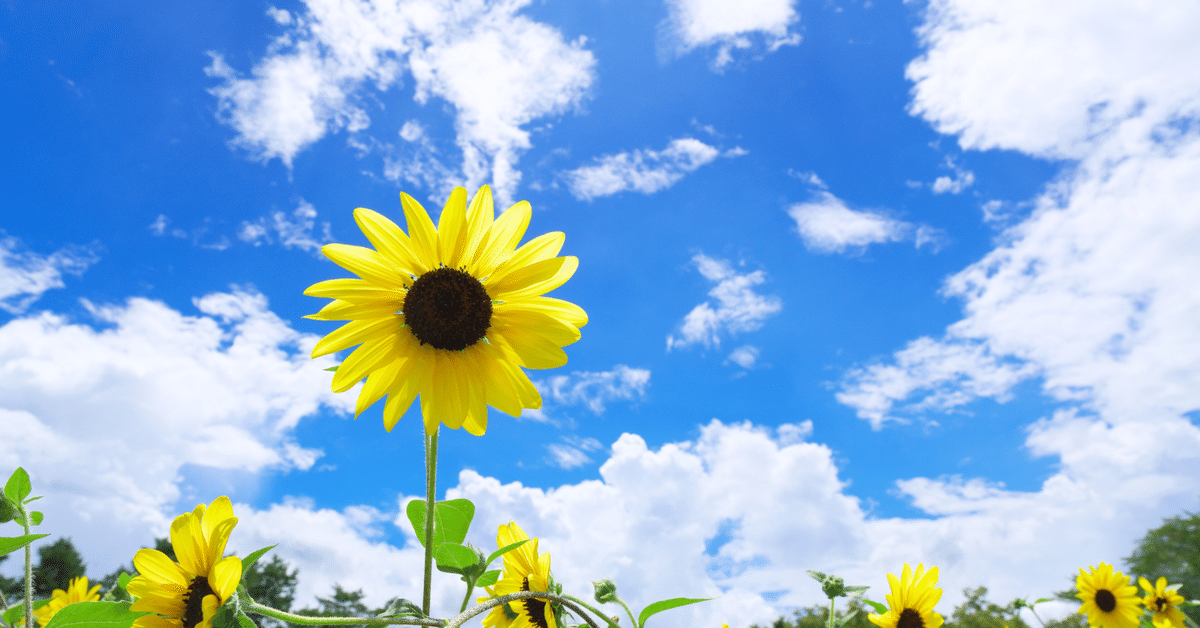
Cherry blossoms at night in spring. Stars in summer. A full moon in autumn. Snow in winter. That's enough to make the sake taste good. If it still doesn't taste good, it's a sign that something is wrong within yourself27
"In spring, the cherry blossoms at night. In summer, the stars. In autumn, the full moon. In winter, the snow. That's enough to make the sake taste good. If it's still not good, then it's a sign that something is wrong within yourself."
These are the words of Hiko Seijuro from "Rurouni Kenshin."
In the twenty-four solar terms, the period from July 23rd to August 7th is called "Taisho" (Great Heat). The azure sky, towering cumulonimbus clouds, and the yellow sunflowers make for a quintessential summer scene.
"Taisho" is the hottest period of the year, with "extreme heat days" where temperatures often exceed 35°C, making it dangerous to be outside during the day.
"Kamakura or not, even Buddha Shakyamuni is a handsome man among the summer foliage."
The term "summer foliage" refers to trees that are lush in summer. This poem by Akiko Yosano praises Shakyamuni as a handsome man.
The seasonal ingredients during "Taisho" are eel, watermelon, and grapes.
Everyone knows about eating eel on "Doyo no Ushi no Hi" (Day of the Ox during the Dog Days).
But what does "Doyo no Ushi no Hi" mean?
"Doyo" refers to the 18 days before the change of each season: "Risshun" (beginning of spring), "Rikka" (beginning of summer), "Risshu" (beginning of autumn), and "Ritto" (beginning of winter). According to the Chinese five-element theory, each season is associated with an element: "Wood" in spring, "Fire" in summer, "Metal" in autumn, and "Water" in winter. "Earth," not fitting any season, was assigned to the transition periods, thus called "Doyo."
The "Ushi" in "Doyo no Ushi no Hi" refers to the Ox in the twelve zodiac signs. Since Ox is the second sign, during the 18 days of "Doyo," there are two days called "Ushi no Hi": the second day (first Ox) and the fourteenth day (second Ox). The "Ushi no Hi" during the "Taisho" period is the hottest time of the year, which is why the custom of eating eel to gain strength has become popular in Japan. In 2024, "Doyo no Ushi no Hi" falls on July 24th and August 5th. Let's eat eel to gain energy and get through the hottest period of the year.
Watermelon is also a summer staple. The crisp, sweet, and juicy watermelon helps to fend off the summer heat. Watermelon contains 90% water, as well as minerals, vitamins, sugars, and amino acids, making it an ideal food for preventing heat exhaustion and heat stroke.
Speaking of watermelon, the distinctive green rind with black stripes is memorable. It's believed that the fruit's unique appearance evolved to make it more noticeable to birds, who would disperse the seeds. The center of the watermelon is the sweetest, which is thought to have evolved to encourage animals to eat the seeds, aiding in seed dispersal.
Grapes contain various nutrients such as polyphenols, glucose, and potassium. They also contain various polyphenols like anthocyanins, resveratrol, and tannins. Anthocyanins can help prevent eye strain and arteriosclerosis. Resveratrol inhibits the activity of the enzyme collagenase, which breaks down collagen. This helps prevent the reduction of collagen, potentially reducing wrinkles and sagging skin.
The introduction of grapes to Japan is attributed to various theories. One suggests that in the Nara period, a high priest named Gyoki was visited by the Medicine Buddha holding grapes in a dream while he was practicing in Kai Province. Gyoki then brought grapes from the continent to Katsunuma as medicine. Indeed, Katsunuma is still known for its grapes today.
By the way, the "Kyoho" grape, which many associate with Yamanashi Prefecture, actually originated in Shizuoka Prefecture. Named after the view of Mount Fuji from its cultivation site, "Kyoho" is renowned for its size and taste, earning it the title "King of Grapes."
The key factors that make food delicious are twofold. One is hunger. The other is enjoying seasonal ingredients. Let's savor seasonal ingredients, nourish our hearts and bodies, and get through life today.
この記事が気に入ったらサポートをしてみませんか?
